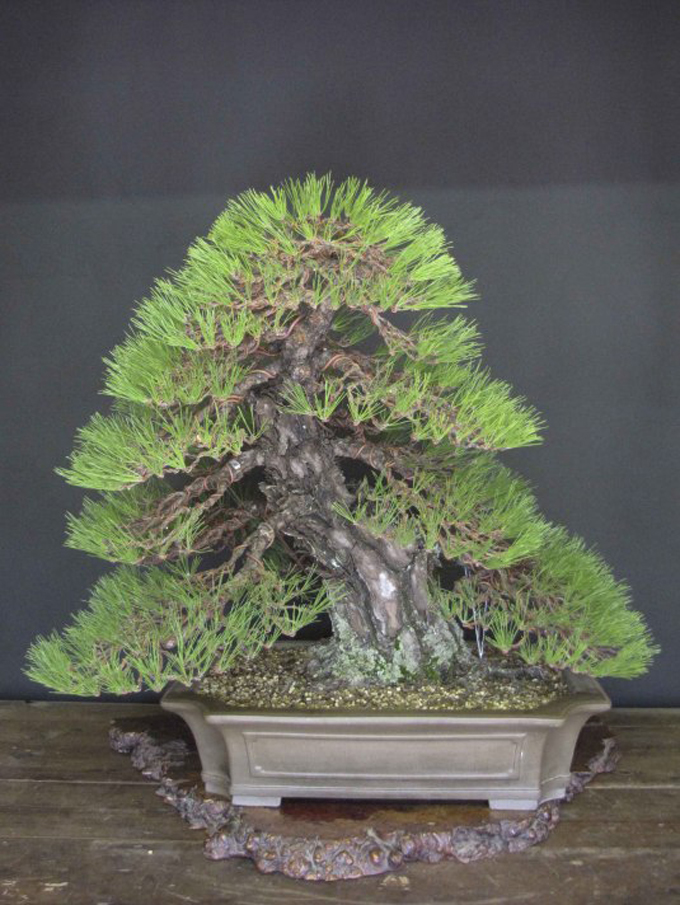 Kishu shimpaku grafted onto a Seirra juniper. Several artists have contributed to the styling of this powerful old collected tree. The latest (when this photo was taken back in 2013) is Peter Tea. You can follow the progression of Peter’s work on this tree and much more on his excellent blog.
Kishu shimpaku grafted onto a Seirra juniper. Several artists have contributed to the styling of this powerful old collected tree. The latest (when this photo was taken back in 2013) is Peter Tea. You can follow the progression of Peter’s work on this tree and much more on his excellent blog.
The other day I happened upon a unique and worthy new (for me) bonsai blog that had been hiding in plain site (see our last post) since October of 2011. It’s called Yenling Bonsai and it belongs to Jeremiah Lee.
In the course of familiarizing myself with Jeremiah’s handiwork I came across this October 2012 interview with Peter Tea. Though I suspect that some of you have discovered Yenling Bonsai, I also suspect that many of you haven’t. Which means you haven’t had the good fortune of reading Jeremiah’s interview with Peter (there’s much more to recommend you to Yenling Bonsai, but we’ll start with this).
Before we get to the interview, just a word about Peter Tea. Gifted bonsai apprentice/artist and great writer too (okay, eight words). We’ve featured Peter many times here on Bark and will no doubt continue doing so. And of course, we always recommend that you visit Peter’s blog yourself. It’s a journey worth taking.
Meanwhile, we won’t publish the whole 28 Questions for Peter Tea interview here. Just enough to peak your interest and prompt you to pay a visit to Yenling Bonsai. We’ll put Jeremiah in italics and Peter in plain text:
I recently caught up with Peter and was able to ask him several more questions I had and he was kind enough to answer. I thought I would share these, so here are the 28 questions and answers below. Thank you Mr. Tea!
1. What do you think you will learn or focus on in 2013 as opposed to what you’ve learned and focused on in 2012?
A. 2012 was a overload of new Bonsai information for me. It reinforced what I’ve learned in the past, yet also got me to rethink my approach and philosophy in Bonsai. For 2013, I plan to continue honing the skills I’ve learned in the past, and be more focused on more varieties and better recognizing the little things that make each species used in Bonsai interesting and unique.
2. What do you think Bonsai in the US will be like 20 years from now?
A. The US is such a large country and Bonsai levels vary greatly. I see a huge leap in quality and enthusiasm as I’m continuing my apprenticeship today. There are young and talented bonsai professionals hitting the bonsai scene and I can only see a up swing in Bonsai and a new higher standard in American Bonsai.
 This photo appeared here on Bark back in 2011. Here’s the caption: An old Black pine at Aichi-en bonsai nursery, after Peter Tea worked on it for three days.
This photo appeared here on Bark back in 2011. Here’s the caption: An old Black pine at Aichi-en bonsai nursery, after Peter Tea worked on it for three days.
3. Name 1 or 2 non bonsai related lessons Mr. Tanaka has taught you during your apprenticeship?
A. It’s okay to have fun too.
…..
8. If Akadama ran out in the US. What mixes would you start experimenting with?
A. Akadama is an interesting soil because it evolves with the root system. At first, it holds only so much water, then as the tree grows more roots and the akadama starts to break down, it holds even more water for all the new roots. I’m not sure what other types of material I can find that will do similar things other then firing some clay myself. If I couldn’t come up with a substitute, I would probably use porous type stones in the mix only such as lava, pumice, etc.
……
12. If any, what types of US natives would you like to work with or experiment with?
A. We are fortunate in the United States with all the great native species to choose from. I like the native junipers and pines, but what I would really love to experiment with are Coast live Oaks and Valley Oaks. Done well, they have such a good feeling to them.
……
16. What’s the best way for people in the US to obtain top notch material?
A. I believe that learning from a skilled and qualified professional will help us all in first recognizing what good material is. Then at that point, it’s a matter of growing, collecting or importing trees. Personally I think growing and collecting are the best way to get nice material. Importing works for me as well but is much more limited with all the restrictions.
……
26. What type of liquid fertilizer if any is used at Aichien and how often is it applied?
A. We don’t use liquid fertilizer at Aichien. We use ground up rapeseed and put them in tea bags. We apply them to different trees during different times of the year.
Visit Yenling Bonsai for the entire interview.
 This photo of Peter working on a Black pine at Aichi-en appears with the interview on Yenling Bonsai.
This photo of Peter working on a Black pine at Aichi-en appears with the interview on Yenling Bonsai.
BTW: for the two of you who have bothered to read this far, I freely admit that I picked two of the questions above because they mention products we sell.